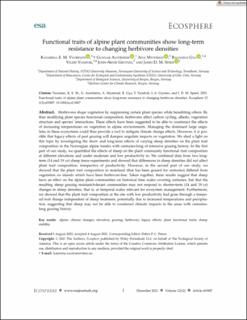| dc.contributor.author | Vuorinen, Katariina Elsa Maria | |
| dc.contributor.author | Austrheim, Gunnar | |
| dc.contributor.author | Mysterud, Atle | |
| dc.contributor.author | Gya, Ragnhild | |
| dc.contributor.author | Vandvik, Vigdis | |
| dc.contributor.author | Grytnes, John Arvid | |
| dc.contributor.author | Speed, James David Mervyn | |
| dc.date.accessioned | 2022-03-24T13:33:24Z | |
| dc.date.available | 2022-03-24T13:33:24Z | |
| dc.date.created | 2022-01-03T11:12:59Z | |
| dc.date.issued | 2021 | |
| dc.identifier.citation | Ecosphere. 2021, 12 (12), . | en_US |
| dc.identifier.issn | 2150-8925 | |
| dc.identifier.uri | https://hdl.handle.net/11250/2987428 | |
| dc.description.abstract | Herbivores shape vegetation by suppressing certain plant species while benefitting others. By thus modifying plant species functional composition, herbivores affect carbon cycling, albedo, vegetation structure and species' interactions. These effects have been suggested to be able to counteract the effects of increasing temperatures on vegetation in alpine environments. Managing the dominant large ungulates in these ecosystems could thus provide a tool to mitigate climate change effects. However, it is possible that legacy effects of past grazing will dampen ungulate impacts on vegetation. We shed a light on this topic by investigating the short- and long-term effects of varying sheep densities on the plant trait composition in the Norwegian alpine tundra with centuries-long of intensive grazing history. In the first part of our study, we quantified the effects of sheep on the plant community functional trait composition at different elevations and under moderate and low productivity in. We combined data from two long-term (14 and 19 yr) sheep fence experiments and showed that differences in sheep densities did not affect plant trait composition, irrespective of productivity. However, in the second part of our study, we showed that the plant trait composition in mainland (that has been grazed for centuries) differed from vegetation on islands which have been herbivore-free. Taken together, these results suggest that sheep have an effect on the alpine plant communities on historical time scales covering centuries, but that the resulting sheep grazing resistant/tolerant communities may not respond to shorter-term (14 and 19 yr) changes in sheep densities, that is, at temporal scales relevant for ecosystem management. Furthermore, we showed that the plant trait composition at the site with low productivity had gone through a temporal trait change independent of sheep treatment, potentially due to increased temperatures and precipitation, suggesting that sheep may not be able to counteract climatic impacts in the areas with centuries-long grazing history. | en_US |
| dc.language.iso | eng | en_US |
| dc.publisher | Wiley | en_US |
| dc.rights | Navngivelse 4.0 Internasjonal | * |
| dc.rights.uri | http://creativecommons.org/licenses/by/4.0/deed.no | * |
| dc.title | Functional traits of alpine plant communities show long-term resistance to changing herbivore densities | en_US |
| dc.type | Peer reviewed | en_US |
| dc.type | Journal article | en_US |
| dc.description.version | publishedVersion | en_US |
| dc.source.pagenumber | 16 | en_US |
| dc.source.volume | 12 | en_US |
| dc.source.journal | Ecosphere | en_US |
| dc.source.issue | 12 | en_US |
| dc.identifier.doi | 10.1002/ecs2.3887 | |
| dc.identifier.cristin | 1973599 | |
| dc.relation.project | Norges forskningsråd: 262064 | en_US |
| cristin.ispublished | true | |
| cristin.fulltext | original | |
| cristin.qualitycode | 1 | |

